Ever wonder why “found family” anime hit harder than most? Here’s the emotional and psychological truth behind anime’s most beloved trope — and why we crave it.
Introduction: The Comfort in Not Being Alone Anymore
There’s a reason anime like Naruto, One Piece, Demon Slayer, and Spy x Family stay with us long after the credits roll. It’s not just the action, the art, or the flashy powers — it’s the people.
More specifically, it’s the families we watch characters build. Not blood-related, but bonded through pain, loyalty, and shared dreams — the “found family.”
You see, in real life, most of us don’t get a perfect family. We get chaos, misunderstandings, distance. So when anime shows us strangers who slowly, painfully, choose each other, it hits us where it hurts — and heals us where we didn’t know we needed it.
Let’s break down why the “found family” trope in anime works so powerfully, both from a storytelling and psychological perspective.
What Is a “Found Family” Anime?
“Found family” anime are stories where the main characters form deep, familial bonds outside of traditional blood ties.
Common Traits of the Found Family Trope:
- Characters start as loners, misfits, or outcasts.
- Their relationships develop through shared hardship or survival.
- They protect and uplift one another like family — even if they never say the word.
- Emotional climaxes revolve around trust, loyalty, or sacrifice.
Think of it as family by choice, not chance — and that’s what makes it so profound.
Why Found Family Stories Are So Common in Anime
Anime, especially shonen and slice-of-life genres, thrives on emotional connection. The “found family” trope is so prevalent because it fits seamlessly with Japanese storytelling values like nakama (comradeship) and kokoro (heart/spirit).
It’s also a universal fantasy — to be seen, accepted, and loved despite your flaws.
From Fullmetal Alchemist: Brotherhood to My Hero Academia, anime repeatedly reminds us that:
Blood might make you related, but love and loyalty make you family.
The Psychology Behind the Found Family Trope
Why do found family stories resonate so deeply — especially with modern audiences?
Because they touch on core emotional needs rooted in human psychology.
1. The Need for Belonging
Humans are wired for connection. Psychologists like Abraham Maslow placed “love and belonging” just above basic needs like food and safety.
Found family anime show characters — often traumatized or abandoned — rediscover belonging.
When Tanjiro finds comfort in Nezuko and the Demon Slayer Corps, or Naruto earns Iruka’s acceptance, it reflects our own craving to be seen and loved despite our brokenness.
2. Healing Through Chosen Bonds
Real families can wound us. Found families show us healing is possible elsewhere.
It’s why shows like Made in Abyss or Clannad: After Story make us sob — because we watch people earn love, not inherit it.
3. Rebellion Against Isolation
In an increasingly digital, disconnected world, these stories fight loneliness.
Found family anime validate the belief that it’s okay if your “real” family doesn’t understand you — you can find people who do.

Top 10 Found Family Anime That Perfectly Capture the Trope
Let’s spotlight the best of the best — the ones that don’t just show found family but embody it.
| Anime | Found Family Dynamic | Why It Hits Hard |
|---|---|---|
| One Piece | Straw Hat crew | Loyalty beyond blood; dream-driven unity |
| Naruto | Team 7, Iruka, Jiraiya | Redemption and belonging for an orphaned outcast |
| Fullmetal Alchemist: Brotherhood | Winry, Mustang’s team | Shared grief and purpose |
| Demon Slayer | Tanjiro, Nezuko, Hashira | Compassion and shared survival |
| Spy x Family | Loid, Yor, Anya | Family built on lies that becomes real |
| Attack on Titan | The 104th squad | Bonds forged in trauma and loss |
| Jujutsu Kaisen | Gojo, Itadori, Megumi, Nobara | Teacher-student loyalty and emotional protection |
| Haikyuu!! | Karasuno team | Found family through shared dreams and teamwork |
| Toradora! | Ryuuji & Taiga | Emotional intimacy without blood ties |
| Cowboy Bebop | Crew of the Bebop | Loneliness meets reluctant companionship |
Each of these hits differently, but the theme is the same — “You don’t have to be alone anymore.”

The Emotional Stages of Found Family in Anime
If you’ve noticed, most found family anime follow a familiar emotional progression. Let’s call it The Four Stages of Found Family.
Stage 1: The Lonely Beginning
A character who’s isolated, traumatized, or misunderstood. (Example: Naruto, Ayanokoji, Denji).
Stage 2: The Reluctant Connection
They meet others — often by accident — and form uneasy alliances.
Stage 3: The Breaking Point
Conflict or tragedy tests their bond. Someone leaves. Someone sacrifices. The audience cries.
Stage 4: The Choice to Stay
Despite pain, they choose to stay together. That choice, not blood, makes them family.
This emotional arc gives the trope its power — it’s both heartbreak and hope in motion.
Why “Found Family” Hurts So Good
There’s a bittersweet truth about found family:
It’s beautiful because it’s fragile.
These bonds are built on choice, not obligation — and that means they can end.
When anime like Vivy: Fluorite Eye’s Song or Vivy: Evergarden explore loss, it’s devastating because that family was chosen.
We cry because we know the risk of loving people who don’t “owe” us love — and we’d take that risk anyway.
Cultural Context: Why Japan Excels at Found Family Themes
In Japanese culture, community and harmony (wa) often outweigh individuality.
Found family anime balance that by showing individuals creating their own harmony, outside traditional social structures.
This mirrors real-world Japan’s shifting social dynamics — declining marriage rates, urban loneliness, and found communities online.
Anime becomes a reflection and comfort, showing that emotional connection doesn’t have to follow societal rules.
Modern Evolution: Found Family in New-Gen Anime
The trope isn’t fading — it’s evolving.
Newer anime like Buddy Daddies, Frieren: Beyond Journey’s End, and Blue Period reinterpret found family with emotional realism.
- Buddy Daddies modernizes it through a queer-coded domestic partnership.
- Frieren explores loss and legacy — found family that outlives you.
- Blue Period reframes it as artistic belonging, not just friendship.
The message is clear: found family isn’t just about survival anymore — it’s about identity.

The Science of Why We Cry Over Found Family Anime
Psychologically, found family narratives trigger oxytocin release — the same hormone tied to bonding and empathy.
When we watch emotional moments of trust, comfort, or sacrifice, our brains respond as if we’re part of that family.
That’s why when Zoro says “I’ll become the world’s greatest swordsman” or Anya hugs Loid after a fake mission, we don’t just watch — we feel seen.
It’s emotional simulation. And it works every time.
Why Found Family Anime Matter More Than Ever
In an era of burnout, isolation, and fractured relationships, “found family” stories remind us of emotional possibility.
They tell us that connection can be chosen, that love doesn’t have to be perfect to be real, and that even misfits deserve belonging.
It’s not escapism — it’s emotional survival.

FAQs About Found Family Anime
Q1: What defines a found family anime?
➡ It’s when unrelated characters form deep familial bonds through shared emotional journeys.
Q2: Why do found family stories feel more powerful than traditional families?
➡ Because they’re earned, not given. The love feels deliberate, not obligatory.
Q3: What’s the most emotional found family anime ever made?
➡ Clannad: After Story and One Piece tie for emotional destruction (in the best way).
Q4: Are found family themes only in anime?
➡ No — Western media like Guardians of the Galaxy and The Mandalorian use it too, but anime executes it more deeply.
Q5: Why do fans relate so hard to this trope?
➡ Because many of us have felt alone — and these stories remind us that love can be found, not just born into.
Q6: What upcoming anime explore this trope?
➡ Solo Leveling, Frieren: Beyond Journey’s End, and Delicious in Dungeon are all carrying that torch in 2025.
Conclusion: The Family We Choose Matters Most
“Found family” anime hit hard because they speak the truth we all live quietly — that home isn’t always where we’re born, but where we’re understood.
When anime gives us moments like the Straw Hats laughing after a battle, or Team 7 standing together despite everything, we see our own search for belonging reflected back.
That’s why it hurts.
That’s why it heals.
And that’s why we keep watching. 💫
External Link: For more deep-dive anime analyses, check out Anime News Network.




